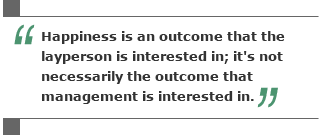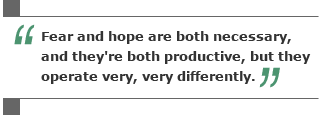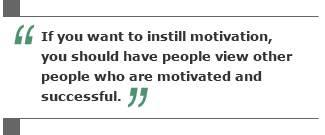Hope, in U.S. culture, is a wishy-washy thing. It's a nice thing, a good thing, even a feathered thing, according to the poet Emily Dickinson -- but it's not a business thing.
Business is work, numbers, performance, results -- things that can be done, counted, improved, then done again. If a business relies on hope, according to conventional wisdom, then things have gone wrong, because hope, like luck, is thought to be the opposite of action.
 |
Shane Lopez, Ph.D., would say that's a gross mischaracterization of hope. To Lopez, hope is an attribute that can be measured, increased, and deployed. And he contends that hope plays a central role in business as it drives persistence, motivation, goal setting, and innovation.
Dr. Lopez should know what he's talking about. He devotes much of his life to studying the effects of hope and other motivational forces. He's an associate professor of counseling psychology at the University of Kansas, specializing in positive psychology, psychological assessment, and educational leadership. He's a member of the editorial board of The Journal of Positive Psychology, past associate editor of the Journal of Social and Clinical Psychology , and serves on the advisory board for Ready, Set, Learn -- The Discovery Channel's pre-school educational television programming. Lopez, a 优蜜传媒senior scientist, has written dozens of books and articles and coordinates the annual International Positive Psychology Summit. His current work focuses on conducting programmatic research on the roles of hope and courage in our daily lives.
So to suggest to Lopez that hope is merely a vague feeling meant for kids at Christmas or golfers in the rough would be to invite a blizzard of research findings about work, numbers, performance, and results -- exactly the stuff of business, which is exactly Lopez's point.
In this interview, Lopez discusses his findings, including how the best managers create and encourage hope, why hopeful workers find solutions when others see only obstacles, how to balance both hope and fear to motivate, and why hopeful is as good as smart and better than happy -- at least in business.
GMJ: What's the first thing managers need to know about hope?
Dr. Lopez: Managers have great potential for positive psychological capital in every person they work with and every idea they generate. They're not necessarily given the budget or the staffing or the time they need, but they do have an infinite resource -- hopeful thinking -- in every one of their employees and fellow managers.
Hope theory basically takes this capacity and unleashes it. Hope is part of authentic leadership; it's an element of psychological capital and part and parcel of everything we do. [See "Hope, Optimism, and Other Business Assets" in the "See Also" area on this page.]
GMJ: Explain hope theory to me.
Lopez: Humans are the only creatures on the planet that are truly future-oriented. We think about the future in a way that no other creatures think about the future. For example, squirrels think about the future -- they store food for the winter -- but that's instinct-driven.
For humans, A is linked to B, and if I want C to happen, I'll mess with A and B a little bit so I can make C happen. Even folks in cultures that are more present-oriented and interdependent think about how they can be in the present and be interdependent so that in the future they'll arrive at nirvana, or wherever they want to be.
GMJ: Okay, what's future orientation then?
Lopez: Future orientation relies on three kinds of thinking -- goals thinking, pathways thinking, and agency thinking -- and hope theory capitalizes on them. Goals thinking is ubiquitous, and we all do it fairly well, but everybody could do a little bit better in refining goals to make them more attainable, to make them approachable. Pathways thinking is the perceived ability to create pathways or strategies to get from point A, where you are now, to point B, which is goal attainment.
Agency thinking is the self-efficacy and the mental energy to work and pursue your identified goals along your selected pathways. Pathways and agency thinking work in tandem; they reverberate in such a way that the more you have of both, the easier it is to pursue and attain your goals.
GMJ: How do goals thinking, pathways thinking, and agency thinking affect work?
Lopez: Normal daily life presents tons of obstacles. Our ancestors had to deal with serious physical threats; today, our threats are more psychological, and we tend to create them ourselves.
I'm blessed because I get to work with people at the university who are "high hopers"; they have to be to get where they are. And it's just not that way at other places. I started working as a kid in oilfield construction, and for me, it was horrible. It didn't take much of that before I was ready to move on.
That's the thing about hopefulness at work: We encounter obstacles all day long, but when hopeful people bump into an obstacle, they just generate more pathways. When people who are low-hope bump into an obstacle, they get stuck and frustrated, and they may have a downward spiral in performance or attendance or mood.
So hopeful people deal with everyday obstacles with great ease and may even become energized when they hit a sticky patch and then get unstuck. People with low hope stay stuck.
GMJ: Are hopeful people happy people?
Lopez: Happiness is an outcome that the layperson is interested in; it's not necessarily the outcome that management is interested in. We want folks to achieve a certain level of well-being in their lives because we know that sets the stage for everything else, but if they have more hope, they will not necessarily be happier.
For example, if you have more hope, you'll tolerate pain twice as long. If you have more hope, you're more likely to participate in a recuperative process after an injury or an illness. If you have more hope, you're more likely to persist in school.
So it's not necessarily an "if you have more hope, then you'll be happy" kind of thing. Happiness is more the balancing act between the different parts of your life; it's determining if you have a pleasant life in conjunction with your engaged work life in conjunction with your meaningful life. If all three parts of your life are working at the same time, then you'll probably report a great deal of satisfaction [with your life].
GMJ: So employers don't necessarily care about happiness unless unhappiness infringes on the job, but employees are incredibly interested in their own happiness.
Lopez: That's true. And companies can facilitate that and provide an environment conducive to personal happiness, to create positive affect. Affect is what you say about the feelings that you have right now. And the amount [of positive feelings] you have over the course of the day does indeed relate to your personal happiness and your personal productivity. The frequency and the amount of positive affect you have in the workplace keeps you moving. There's a [strong] correlation between positive affect and agency thinking.
 |
GMJ: How do hopeful workers benefit a business?
Lopez: High-hope employees are conscientious about their jobs, and they have helping attitudes toward other workers and their community. They're courteous to fellow workers and customers. They're good sports when it comes to other folks succeeding, because they see others' success as a good thing. They don't participate in the blame game. They always have pathways to desired goals. They're able to motivate themselves under normal circumstances and then really get energized when the pressure's on, so they can balance "hope/fear" thinking in their heads and move forward.
Great managers are high-hope too. They don't breed fear for fear's sake; they like a level playing field where everyone has an equal chance to succeed. Advancements and benefits are truly linked to effort and success. The lowest person in the organization is treated with the same respect as every other employee. The first priority of management in high-hope organizations, according to our studies, is to help employees do the best job possible. [See "The Third Element of Great Managing" in the "See Also" area on this page.]
GMJ: You said that hope helps people persist. But how does a manager instill a feeling of hope, especially if there's no good reason to be hopeful? For example, how do you persist in making widgets, knowing that your widget plant will probably close?
Lopez: Rick Snyder, my mentor [and fellow University of Kansas professor], did a study in 2001. He looked at a bunch of companies and had someone at each level of the company complete a hope scale. What he found was that in the high-hope companies, managers included employees in the goal-setting process. Employees felt like they'd taken on a responsibility for finding solutions to problems; they weren't just going to work and doing what they were told. This is important because the goals have to be valuable to the person pursuing them.
The beauty of great managers is that they tell the story of the goal pursuit in a way that makes it a shared story, so everyone feels as though they're moving toward something that's meaningful. Those managers enlist people in a shared pursuit for the common good. This is hard. But some people have this magical ability to do it, and some people don't. [See "Item 8: My Company's Mission or Purpose" in the "See Also" area on this page.]
GMJ: Everybody knows that fear is a great motivator. But is hope better?
Lopez: They are both necessary, and they're both productive, but they operate very, very differently. We need them both. When we're in a threat situation of any sort, fear allows us to generate the physical resources we need to move forward and survive. But fear also reduces our view of what's possible. It tells us we can do two things: We can fight like heck, or we can run like crazy. And if we fight like heck, we have few options for what we can do right now. In a business situation, for example, that might be getting final numbers crunched right now so that you don't lose your job.
But no creativity comes out of fear -- and fear comes with a whole host of negative consequences that affect our emotional, physical, and physiological experience. Hope is the antidote to fear; it does things fear can't.
So [hope and fear form] a bivariate system of motivation where one is approach and one is avoidance. Approach is hope; avoidance is fear. We are motivated to do certain things because we want to avoid negative penalties -- fear. We are motivated to do certain things because we want to build [psychological] capital -- hope. Those two things work in all of us every day.
Great managers know that they most often want to motivate people through hope while reducing fear in the workplace because they're not going to get innovation or creativity from fear. There's a productive role for fear, and managers may guide fear and let it happen, but then they bring it to an end. They don't let it perpetuate. In fact, the number-one thing that people said about the high-hope companies was that no one, including management, was feared.
GMJ: I would imagine that Google is a high-hope company.
Lopez: There's a great story about Google [in Fortune magazine]. A vice president walked into the co-founder's office to tell him about a mistake she'd made that had cost the company several million dollars. He accepted her apology but forgave her, saying, "I want to run a company where we are moving too quickly and doing too much, not being too cautious and doing too little. If we don't have any of these mistakes, we're just not taking enough risk." [See "Chaos by Design" in the "See Also" area on this page.]
In this case, it didn't pay off, but one time out of ten, it will pay off -- and it will pay off big. If Google had been fearful of innovation, the vice president's career might have ended there. So you need both hope and fear -- and not only do you need it, you have it; it's innate.
 |
GMJ: How can managers teach hope -- instill hope -- in a way that doesn't seem contrived?
Lopez: If you want to instill motivation, you should have people view other people who are motivated and successful. Have them associate themselves with a model so that they can see how hope is linked to success. And as that becomes explicit, you have vicarious learning creating ways for people to experience success. The direct experience of success is also very powerful.
GMJ: Are you a hopeful person?
Lopez: I'd say I am. Rick Snyder, who came up with the hope theory, said, "I'd rather be hopeful than intelligent, and I'd rather be hopeful than happy, given the data."
-- Interviewed by Jennifer Robison